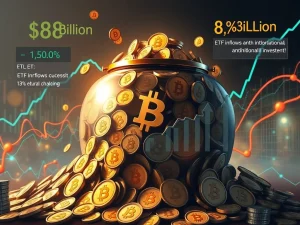Urgent Crypto Directive: US Federal Agencies Must Report Holdings to Treasury!

Hold onto your hats, crypto enthusiasts! Washington D.C. is making moves again, and this time it involves Uncle Sam’s own digital wallets. Get ready for a major shakeup as US federal agencies are mandated to come clean about their crypto holdings to the Department of the Treasury. The deadline? A surprisingly close April 7th. This isn’t just another bureaucratic procedure; it signals a significant step in how the US government is approaching the burgeoning world of digital assets. Let’s dive into what this means for the crypto landscape and what secrets these reports might unveil.
Why the Sudden Scrutiny on Crypto Holdings?
This directive stems from an executive order signed earlier this year, spearheaded by former President Donald Trump. It’s all part of a broader strategy to get a handle on the government’s involvement with digital assets. Journalist Eleanor Terrett, citing a White House insider, broke the news about the April 7th deadline for agencies to submit their Treasury report on crypto assets to Treasury Secretary Scott Bessent. While the details of these holdings will remain under wraps for now, the very fact that this report is being compiled is noteworthy. The question on everyone’s mind: will these findings ever see the light of day? For now, it remains a closely guarded secret.
Bitcoin Reserve: A Digital Fort Knox in the Making?
This reporting requirement isn’t happening in a vacuum. It’s directly linked to the establishment of a Strategic Bitcoin Reserve and a larger Digital Asset Stockpile. Imagine a digital Fort Knox, specifically for Bitcoin! This Bitcoin Reserve will be initially funded with BTC seized by federal agencies through legal actions. David Sacks, the White House AI and crypto czar, envisions this reserve as a long-term store of value, emphasizing that the US government won’t be selling off any of its Bitcoin. This is a stark contrast to past actions where the US government sold off a substantial amount of Bitcoin for what now seems like a pittance.
Consider these key points about the Bitcoin Reserve:
- Strategic Store of Value: The reserve is designed for long-term holding, not short-term trading.
- Seizure-Funded: Initial funding comes from Bitcoin forfeited through civil and criminal cases.
- No Selling Policy: The US government, for now, plans to hold onto the Bitcoin in the reserve.
Sacks himself pointed out the missed opportunity, highlighting how the US government’s previous sale of 195,000 BTC for a mere $366 million could have been worth billions today. This new reserve signals a potential shift in perspective, recognizing Bitcoin’s long-term value proposition.
Expanding Beyond Bitcoin: The Digital Asset Stockpile
Beyond the Bitcoin Reserve, the initiative also includes a broader Digital Asset Stockpile. This stockpile aims for “responsible stewardship” of all government-held crypto assets under the Treasury’s watchful eye. Unlike the Bitcoin Reserve, this stockpile allows for potential sales of assets. Interestingly, Trump himself has mentioned a range of cryptocurrencies, including XRP, Solana, Cardano, and even Ether, as potential components of this crypto reserve. This suggests a wider embrace of the crypto ecosystem beyond just Bitcoin.
Crypto Regulation and Market Volatility: A Tangled Web
While positive developments like the Bitcoin Reserve might seem bullish for the crypto market, the broader regulatory landscape and global economic factors continue to inject volatility. Just as Trump’s initial election was seen as a positive catalyst for crypto, his subsequent policy moves have demonstrated the potential for market downturns.
For example, the announcement of a 10% tariff on all countries, with even higher rates for major economies like China, Japan, and the EU, sent shockwaves through global markets, including crypto. This tariff announcement on April 5th led to an over 8% drop in the overall crypto market capitalization, pushing it down to $2.5 trillion. This highlights the delicate balance and interconnectedness of crypto markets with traditional finance and global politics.
Navigating the Future of Crypto Regulation
The requirement for US federal agencies to report their crypto holdings is a crucial step in the ongoing evolution of crypto regulation in the United States. While the immediate details remain confidential, the establishment of a Bitcoin Reserve and a broader Digital Asset Stockpile signals a more serious and strategic approach from the US government towards digital assets. Whether this increased scrutiny and strategic holding will ultimately benefit or challenge the crypto market remains to be seen. One thing is clear: the relationship between government, regulation, and cryptocurrency is only just beginning to unfold, and April 7th could mark a pivotal moment in this ongoing saga.









